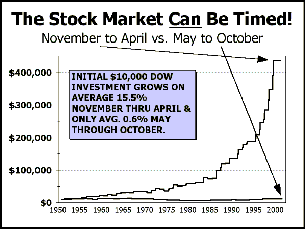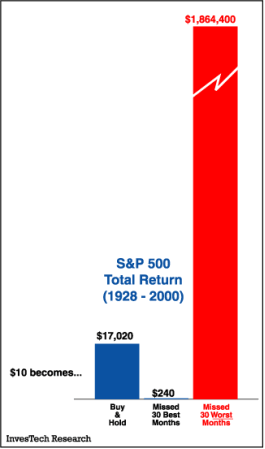Guest
Analyst
June
18, 2001
Buy
& Hold - Myth or Truth?
by Hans Merkelbach
The Fine Art of Re-Balancing Mutual Fund Portfolios
An often-touted mantra in the mutual fund industry is that asset allocation, a.k.a. diversification among different asset classes, is the answer to achieving above average returns. Asset-allocation can work well when all assets including stocks and bonds go up in tandem, but this is rarely the case. Sector-allocation works well during bear markets if invested in risk-averse sectors or inflation-friendly sectors such as Resources, Commodities and Precious Metals.
A financial planner or broker should have the courage to advise clients to be invested in sectors which are either friendly to the underlying fundamentals, or exit the market when it becomes obviously overpriced. An advisor's job is to temper the herd mentality, to move you into a safer sector-allocation model. Traditional asset allocation is a simplistic notion of handling the market. An investor should remain content to sit in cash or in fundamentals-friendly sectors.
Mutual fund allocation should be changed gradually and over the length of an economic cycle by sector re-balancing a mutual fund portfolio. A sector weighting, may it be equities, bonds or money market funds, should always be subject to the conservation of capital and to the avoidance of being invested in the wrong type of sector during serious bear markets, first.
About Capital Preservation
Knowledge of the underlying fundamentals, which move the financial markets, helps the investor make informed mutual fund decisions. The key to preserving capital of course and achieving above average "long term" returns is to stay the course with a financially conservative approach in looking after your mutual funds. If you are a do-it-yourself mutual fund investor or you rely on someone else's advice it pays to be critical to ensure good performance in both good and bad markets. To carry out a risk averse strategy results in peace of mind and reduced risk. We've been doing it for our clients for several years. It is not enough to settle into a model and just let the money work for you. Even Warren Buffett doesn't stand still. To reduce risk one has to move to safety when risk becomes greatest in a specific asset-class, thereby putting your retirement moneys out of harms way.
About Risk & Reward
A hidden advantage to mutual fund investing today is that there is a wide range of options for the individual to choose from. Many investors who seek volatility, as a means to higher returns, have traditionally abstained from mutual fund investing. But the volatility in nearly all of the asset classes has been gradually rising. So even the standard index mutual funds, while minimizing the alpha risk through diversification, can offer the aggressive investor a better risk reward ratio than usual.
About Costs
Despite the fact that a lot of folks in this business have been finding fashionable new ways - Discretionary Money Management or Wealth Management - to sell the same old thing, we believe that mutual funds are still the best and most efficient way for some people to invest in the future. With one proviso: we prefer the Front Load or Low Load basis, and recommend against purchasing mutual funds on the Deferred Sales Charge (DSC) commission system. It's one of the costliest ways to buy mutual funds and it limits your ability to move from one fund family to another. A lot of emphasis should also be placed on the MER (Management Expense Ratio) in that the investor should select mutual funds with the lowest MER's. More important is that you have an advisor who knows where to put your monies and into which sector.
About Full Disclosure and Transparency
A special word of thanks to Mr. Joseph Killoran, for the inspiration he gave me to go beyond the ordinary and offer mutual fund investors a unique service based on the principles and disclosures set forth in his Fund Transaction Checklist, an ethical and moral contract between the mutual fund investor and seller: www.investorism.com
The Dead Zone (Reprised)

To buttress the case for reality, twice a year for the last decade, we have presented the case for market timing using a "system" discovered by market historian Yale Hirsch years ago and effective with only two simple investment decisions each year. For more than 50 years, this methodology has produced superior and virtually unmatchable gains, further proof that any spin devised by Wall Street pros is utterly useless in the long run. As our chart clearly illustrates, an initial investment of $ 10,000 in 1950 has grown to $ 426,227 in the months November to April. Our methodology sells the Dow Industrials at the close of trading every April and buys the Dow at the beginning of each November. Conversely, the same $ 10,000 invested in only the months of May through October has grown to a paltry $ 11,750! Hardly worth the effort.
The six-month gains from November through April average 15.5%, so far in excess of the market's own historical record that one wonders why Wall Street strategists are as widely followed as they are! Incredibly, returns for the May to October "Dead Zone" actually peaked 36 years ago in October of 1965 and an investor exposed solely to this six month period since that time would have lost 16.6% of his original investment! It is with some measure of disdain for Wall Street's spinmeisters that we reveal the absolute best consecutive ten year stretch for the months May through October (1988 to 1998) has averaged less than 4.6%. One have needed only to consult a calendar and make a grand total of two investment decisions each year since 1950 to outperform Wall Street's pros by a very wide margin. Of course, there are no guarantees that the methodology will work forever. Despite the obvious caveat that this methodology may not even work this year (2001), we believe the stage is set for another stock market decline into the end of October.
Published by permission: Alan M. Newman, Technical Analyst, HD Brous & Co., Inc. Members New York Stock Exchange - 40 Cuttermill Road, Great Neck, NY 11021 (516)773-1800 Outside NY State (800) 382-7170. http://www.cross-currents.net
NO INDICATOR IS INFALLIBLE. ANY SIGNALS SHOWN OR OFFERED HERE ARE NOT GUARANTEED TO BE PROFITABLE AND ANY AND ALL TRADING OR INVESTMENT DECISIONS SHOULD BE IMPLEMENTED ONLY AFTER CONSULTING WITH YOUR FINANCIAL ADVISOR. THIS PAGE IS PRESENTED HERE FOR INFORMATIONAL PURPOSES ONLY.
"BUY
& HOLD" - a wise strategy?
Only when invested in the asset most friendly to the underlying fundamentals
 A
Buy & Hold strategy is largely dependent on fundamental factors.
There's always the belief that if you only chose equity or bond mutual
funds or a blending thereof, your mutual fund portfolio won't get hit
hard in a bear market. That belief is an historic illusion. "Buy & Hold"
is a safe strategy when you are invested in the asset, which is friendly
to the developing underlying fundamentals, be that Equities, Government
Bonds or Cash.
A
Buy & Hold strategy is largely dependent on fundamental factors.
There's always the belief that if you only chose equity or bond mutual
funds or a blending thereof, your mutual fund portfolio won't get hit
hard in a bear market. That belief is an historic illusion. "Buy & Hold"
is a safe strategy when you are invested in the asset, which is friendly
to the developing underlying fundamentals, be that Equities, Government
Bonds or Cash.
Courtesy of www.investech.com Shown in the graph is the dramatic difference between a blind Buy & Hold strategy versus moving to temporary cash (Money market Funds or Fixed-Income Funds) when the investment climate has turned against the investor. Since 1962, a $10,000 investment in the S&P 500 would have grown to $719,592 through Buy & Hold. In direct contrast, that same $10,000 could have returned 5 times more - $3,332,028 - by following a "safety first " and "risk averse" strategy. This strategy is designed to keep you out-of-bear-markets when the monetary climate turns against the investor.
Past Performance is NOT a Guarantee for Future Results
You will find this Disclaimer in Prospectuses and all sorts of mutual fund advertising but have you ever gauged past performance and the track record of a mutual fund advisor before you engage him/her to manage your sacred retirement monies? I bet that few investors ask for a Performance Resumé. Most investors will blindly entrust their monies to a mutual fund seller or a financial planner who in most but not all cases knows very little about the fundamentals which could affect their fund investments especially in a bear market. Again, past performance is not a guarantee for future results. Keeping that in mind following are the results of fine-tuning a mutual fund portfolio.
|
Return
|
Entry
|
Exit*
|
|
| AGF Japan Fund |
+
72%
|
Nov
1998
|
Jan
2000
|
| AGF Asian Growth Class |
+
105%
|
Nov
1998
|
Jan
2000
|
| Universal Canadian Resources |
+
36%
|
May
2000
|
holding
|
| Universal Precious Metals |
+
47%
|
May
2000
|
holding
|
*The above are a few examples of a sector-balancing strategy. These are not recommendations, which are best left taylored to the individual's needs. Please consult with a registered representative licensed in your province or state.
Hans
Merkelbach - Email
www.strategicsector.com
Hans Merkelbach was born and educated in the Netherlands, but came to Canada in 1956. While in Canada, he worked as stock broker / options broker, a bond trader for Gairdner & Company (now defunct) at the Bank of Montreal, as well as several other investment firms over his career as a financial planning specialist. His stay in Canada was interrupted by a brief stint in the Netherlands from 1970 to 1974 where, as Managing Director of an Insurance Company, he was in charge of some 130 agents whose job it was to sell equity-linked life insurance products.